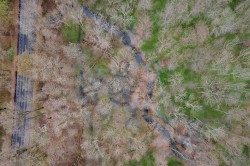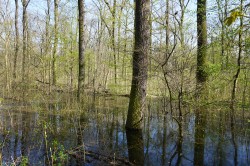Press Release, 22. May 2024
Natural climate protection: new water in historical rivercourses
A project in the Leipzig area shows how floodplain landscapes can be effectively restored in an urban environment
Floodplains are among the most species-rich habitats in Central Europe. They also improve water quality and make an important contribution to flood and climate protection. However, humans have altered many river landscapes to such an extent that they can provide these important benefits only to a limited extent - if at all. But the story doesn’t have to end there. The "Lebendige Luppe" project, which recently ended, shows how such floodplains can be restored to lively and functional ecosystems - even in large cities. A team from the Helmholtz Centre for Environmental Research (UFZ) and Leipzig University provided scientific support for the project carried out between Leipzig and Schkeuditz.

Photo: Michael Vieweg

Photo: Mathias Scholz
The Luppe, a tributary of the Weiße Elster, shares the fate of many rivers in Central Europe. It once regularly flooded large alluvial forests between Leipzig and Halle. In a wide floodplain, watercourses flowed through a species-rich natural paradise that thrived on the changing water levels. There were wet meadows and forests, ponds, and oxbow lakes - a mosaic of habitats for the most diverse requirements. But only a small fraction of this diversity remains. "This is because the water system was completely redesigned from the 19th century onwards", says Dr Mathias Scholz, a floodplain ecologist at the UFZ for more than 25 years. The river was straightened, regulated, and diked, and parts of its floodplain were drained and filled in. In Leipzig, city districts were built on former floodplains. And a newly built, canal-like watercourse was intended to carry floodwater away as quickly as possible. This "Neue Luppe" has cut through former river courses so that they can no longer supply the alluvial forest with water. The floodplain thus lacks its "lifeblood". As a result, its functionality and biodiversity are threatened.
The aim of the "Lebendige Luppe" project, which has now come to an end, was to change this. Since 2012, the cities of Leipzig and Schkeuditz, the Nature And Biodiversity Conservation Union (NABU), the UFZ, and the University of Leipzig have been looking into ways to restore the floodplain landscape between Leipzig and Schkeuditz to a more natural state. The measures are intended to benefit not only the rich flora and fauna of the floodplains but also people. After all, an intact river landscape provides countless benefits. These ecosystems are considered to be the "kidneys of the landscape" and filter excess nitrogenous fertiliser and other pollutants from the water. In addition, alluvial forests act as natural climate protectors and fix larger quantities of the greenhouse gas carbon dioxide than other forests. They also help to mitigate the tangible consequences of climate change.
"An alluvial forest acts like a refrigerator that can considerably reduce temperatures on hot days", says Scholz. The influence on the water balance is also important because floodplains soak up water like a sponge and thus keep it in the landscape for longer. This helps the plants to better survive dry summers. And when the next flood comes, the river overflows its banks and floods the forest and meadows. This is one of the most effective safeguards against flood damage. In this way, some of the floodwaters remain on the floodplain instead of flowing further down the valley and causing destruction there.
Near-natural river landscapes therefore offer good opportunities to do something for biodiversity, the climate, and flood protection at the same time. This is why they are among the ecosystems that need to be increasingly protected and restored in Germany. This is the aim of the "Action Plan on Nature-based Solutions for Climate and Biodiversity" presented by Federal Environment Minister Steffi Lemke at the end of March 2023. Germany’s floodplains could be invaluable; however, this potential is still a long way from being realised.
The extent of this problem is shown in the latest floodplain status report published by the Federal Environment Ministry and the Federal Agency for Nature Conservation in 2021. Along the 79 largest rivers in Germany, two thirds of the original floodplains have been lost because the watercourses have been separated from their floodplains by dykes. What remains is often used intensively and is therefore no longer in a near-natural state. One third of the remaining floodplains are now occupied by intensive agriculture and settlements.
The German floodplain status report therefore emphasises the need to reclaim natural service providers with nature-based solutions. After all, around 220 major restoration projects along the rivers were surveyed between 1983 and 2020. By relocating, dismantling, and slitting dykes, it was possible to temporarily reflood around 7,100 ha of floodplain area. In view of the tens of thousands of hectares that could theoretically be considered for such measures, there is still plenty of room for improvement. Rivers throughout Germany need to be given more space, and more floodplains need to be reorganised in a near-natural way.
At the European level, the EU Biodiversity Strategy is pursuing the ambitious goal of restoring 25,000 km of rivers in Europe by 2030 by removing dams and connecting floodplains. The new European Nature Restoration Law could also provide a new implementation framework for this. However, it has yet to be ratified.
The development of the Luppe shows how worthwhile such endeavours are. "The project team has achieved a lot there in recent years", says Scholz. This means that the five-kilometre-long Burgauenbach stream can now once again overflow its banks during floods, thereby acting as a lifeline for the alluvial forest. The Zschampert is also being transformed from a ditch back into a near-natural stream. Dried-out ponds are once again full of water and thus offer spawning opportunities for amphibians.
Accompanying studies by the UFZ and Leipzig University show that these measures have had a positive effect on the ecosystem. For a long time, typical alluvial forest species such as oak, ash, and elm were no longer able to develop healthily in the areas cut off by the floods. Instead, maple trees had taken hold there. But when the water returns, this process can be reversed.
In an experiment that has been running since 1993, the city of Leipzig floods an area of seven hectares in the southern Leipzig alluvial forest every spring. "The maple population there has already been greatly reduced", says Scholz. "And the oaks planted there are thriving". He expects similar developments at the renaturalised Burgauenbach. "One week after the city had restored the water supply there together with the state water management administration, 20 ha were already flooded", says Scholz.
Even after the end of the current project, the river landscape along the Weißer Elster and the Luppe will continue to recover. However, restoring a condition that has developed over several centuries to a near-natural ecosystem requires intensive cooperation between all stakeholders. And time. Together with the Free State of Saxony, the City of Leipzig is working on a land use and spatial planning concept for 4,750 ha of floodplain area; this corresponds to more than 10% of the urban areas of Leipzig and Schkeuditz. From Scholz’s perspective, the fact that large areas of these floodplains are located in the city makes the project particularly interesting. This allows us to test how best to reconcile urban life and floodplain protection. In this way, the project in Leipzig can become a model for numerous other regions. "Practically all major German cities are located on rivers", says Scholz. "So they should also promote functioning floodplains."
As part of the recently launched EU-funded SpongeBoost project, this sponge function of wetlands along the Weiße Elster and other regions of Europe, which is so important for climate protection, is to be analysed in greater depth.
The "Lebendige Luppe" project was funded by the Federal Agency for Nature Conservation with funds from the Federal Ministry for the Environment, Nature Conservation, Nuclear Safety and Consumer Protection as part of the Federal Biological Diversity Programme and by the Saxon State Foundation for Nature and the Environment.
Additional links:
"Lebendige Luppe" project page: https://lebendige-luppe.de/index.php?article_id=28
Final brochure for the "Lebendige Luppe" project: https://lebendige-luppe.de/media/ll_abschlussbroschuere_web.pdf
Action Plan on Nature-based Solutions for Climate and Biodiversity: https://www.bmuv.de/en/topics/nature-and-biological-diversity/overview-nature-and-biological-diversity/naturebased-climate-action
ENCA Recommendations: https://bioclim2023.adelphi.de/system/files/document/enca-recommendations-wetlands-final.pdf
Status Report on Floodplains: https://www.bfn.de/en/publications/leaflet/status-report-floodplains-2021-floodplains-germany
EU Project "SpongeBoost": https://cordis.europa.eu/project/id/101112906
Further information
Dr. Mathias Scholz
UFZ-Department Naturschutzforschung
mathias.scholz@ufz.de
UFZ press office
Susanne Hufe
Phone: +49 341 6025-1630
presse@ufz.de
In the Helmholtz Centre for Environmental Research (UFZ), scientists conduct research into the causes and consequences of far-reaching environmental changes. Their areas of study cover water resources, ecosystems of the future, environmental technologies and biotechnologies, the effects of chemicals in the environment, modelling and social-scientific issues. The UFZ employs more than 1,100 staff at its sites in Leipzig, Halle and Magdeburg. It is funded by the Federal Government, Saxony and Saxony-Anhalt.
www.ufz.deThe Helmholtz Association contributes to solving major challenges facing society, science and the economy with top scientific achievements in six research fields: Energy; Earth and Environment; Health; Key Technologies; Matter; and Aeronautics, Space and Transport. With some 39,000 employees in 19 research centres, the Helmholtz Association is Germany’s largest scientific organisation.
www.helmholtz.de